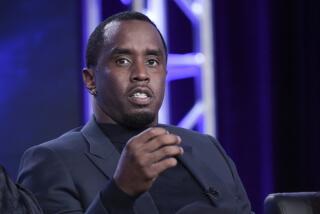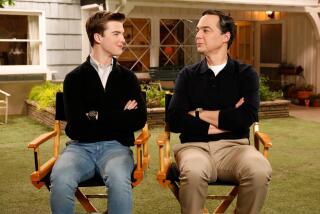DANCE REVIEW : United, They Danced : A Lavish Festival Commemorates the Signing of U.N. Charter
Tuesday night was, as they say, a big night. Capital B. Capital N.
Anyone who was anyone was at the War Memorial Opera House. Also anyone who wasn’t.
To commemorate the 50th anniversary of the signing of the United Nations Charter--in the very same locale--the San Francisco Ballet was opening an international festival of quasi-contemporary dance. The stage accommodated a passing parade representing Moscow, London, Melbourne, Copenhagen and, yes, San Francisco.
And this was just the beginning. Before the festivities--cutely labeled “UNited We Dance”--end on Sunday, companies from 13 nations on five continents will have done their disparate things. Local audiences will have seen 13 unfamiliar works. A little bit of this, and a little bit of that. . . .
Gosh.
According to Helgi Tomasson, artistic director of the San Francisco Ballet, “the festival (is) a way of acknowledging our differences and celebrating our similarities.”
That sounds nice. Over-ambitious, platitudinous, unrealistic, unwieldy and righteously idealistic, perhaps, but certainly nice.
The official statistics are telling. Total budget: $850,000, not including assorted bundles of corporate sponsorship. The ultimate cast is to include 145 dancers in works of 14 choreographers. The hosts, not incidentally, will be responsible for serving the visitors 3,000 meals in 32 seatings.
Wow.
The fancy package comes with interesting seals of approval.
President Clinton, who hasn’t done much to bolster our shaky national involvement in the arts, sent a heartwarming message:
“Dance is a celebration of life, and performances like yours encourage us to gain a deeper understanding of our place in society.”
Gush.
At the beginning of the inaugural program, Frank M. Jordan, mayor of San Francisco, presented Tomasson with the usual congratulatory citation. In the process, he promised the first-nighters that the festival would be “very, very wonderful and very unique.” The mayor’s taste, one hopes, is better than his grammar.
What’s that? You want to know about the dances and the dancing?
Golly.
The first set of performances paled, alas, amid all the hoopla. Spirits were undeniably willing, and intentions were lofty. Energy ran high. But quality remained elusive, and innovation proved scarce.
The opening act came courtesy of a youthful contingent from the beleaguered Bolshoi Ballet (it wasn’t, as some sources suggested, the parent company). In an exercise called “Infanta and Jester,” the Russians suggested that they may want to be progressive but they are still straitjacketed by the ancient conventions of narrative dance.
*
Sergei Bobrov’s choreography concentrated on athletic flailing to convey agonized masculinity, tippy-toe traipsing to convey fickle femininity. In retelling Oscar Wilde’s tale of the wicked beauty who destroys the noble beast, Bobrov relied on a movement vocabulary that invoked little beyond the tawdry cliches that got Valery Panov into Soviet trouble 20 years ago.
The score, Alfred Schnittke’s Concerto Grosso No. 1, sounded vaguely adventurous. Bobrov trivialized it, however, illustrating every quaver with a quiver. Call him literal to a fault.
Olga Lavrenkova skimmed the stage pertly as the Lady. Sergei Antonov suffered elegantly as the Fool. Four danseurs in ghostly white makeup provided neat choral punctuation.
Relief, of sorts, came with the Rambert Dance Company of England and the introduction of Christopher Bruce’s “Meeting Point.” A genuine piece d’occasion, it putatively “celebrates nations coming together.”
In his clever, tongue-in-cheeky dance of diplomacy, Bruce dressed the ensemble in unisex white tie and tails. The smooth politicos danced around each other warily, played courtly games, fidgeted politely, flashed witty hand signals, struck ironic poses that recalled Jooss’ “Green Table,” and ultimately joined in a snazzy-sleazy production number--all to the easy tunes of Michael Nyman. (He was the composer who created the artificially sweetened film score for “The Piano.”)
Although Bruce’s mini-ballet is hardly deep, it is good, edgy, cynical fun. The slick yet gutsy Rambert dancers made the most of it.
The Australian Ballet brought Stanton Welch’s “Corroboree.” A program disclaimer qualified it, significantly perhaps, as “not a literal interpretation of an Aboriginal Australian corroboree.”
The non-literal interpretation turned out to be just another one of those the-natives-are-restless-but-picturesque ritual maneuvers. Stylized sun blazed on Kenneth Rowell’s backdrop while John Antill’s score throbbed gently. Steven Heathcote, resplendent in jockstrap and war paint, did a lot of strenuous stalking. Miranda Coney, seconded by Justine Summers, did a lot of fleshy vamping. The assembled throng did a lot of bounce-crouching sur les pointes. At climax time, the tribal heroine/victim got tossed straight into the air.
Where is Glen Tetley when we need him?
The Royal Danish Ballet, soon to return to Costa Mesa in all its hoped-for glory, sent a dainty pas de deux called “Partita.” Anna Laerkesen, former pride of the Sylphides, provided playful neo-Bournonville choreography to the contrapuntal tunes of Bach (banged out on a concert grand in the pit by Roy Bogas). Silja Schandorff and Kenneth Greve danced with authoritatively muted bravura.
The modest Danes paved the way for the climactic neo-Balanchine flourishes of Helgi Tomasson’s “Handel--A Celebration,” a favorite here since 1989. The large cast, led by an always-eager Anthony Randazzo and an ever-fleet Joanna Berman, offered much fervor, not so much finesse.
The San Francisco orchestra, over-worked and probably under-rehearsed, provided invariably stylish support under Jean-Louis Le Roux and Emil de Cou.
* “UNited We Dance” continues at the War Memorial Opera House, 301 Van Ness Ave., San Francisco, nightly through Sunday with week-end matinees. Tickets $10-$85. (415) 865-2000.
More to Read
The biggest entertainment stories
Get our big stories about Hollywood, film, television, music, arts, culture and more right in your inbox as soon as they publish.
You may occasionally receive promotional content from the Los Angeles Times.






